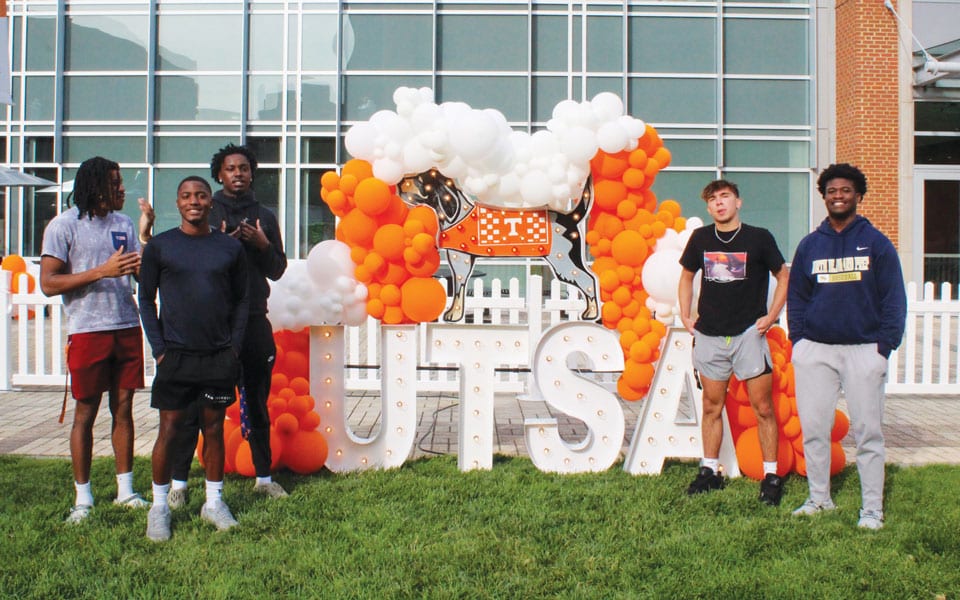
How Donor Funds Ensure Access to the Full Student Experience
As an intern with Oak Ridge National Laboratory, junior Semilore Abiodun-Adeniyi analyzes data from portions of the power grid that enables our country’s electricity, looking for vulnerabilities to cyberattacks which have multiplied in recent years. While he is contributing to the country’s defense, UT Success Academy is empowering his student experience.
“Without UT Success Academy and recommendations from Aaron Dixon [program director], I wouldn’t have my high-profile internships,” says Abiodun-Adeniyi. “Without UTSA I would’ve been more isolated from people and resources. I’m so grateful for the friends I made through UTSA.”
UTSA welcomes all students but was originally developed for men of color who in the past had told the Division of Student Success that they felt they didn’t belong on Rocky Top. Since its 2021 launch, retention rates for students from its target demographic rose from 82 to 87 percent, edging close to UT’s record-breaking 91 percent retention rate. Impressively, 77 percent of second-year students continued to their third year compared to 60 percent prior to UTSA’s creation.
Without the program, some of its 400-plus participants may have left UT, depriving campus of leaders, volunteers, and even research like Abiodun-Adeniyi is completing.
“I love to see participants being their authentic selves and pursuing their interests,” says UTSA Director Aaron Dixon. “Our students are engaged across campus, from orientation leaders to ambassadors to president for Student Government Association. Our population may be small, but its impact is large.”
Retention rates for students rose to
of second-year students continued to third year.
Since the program’s launch in 2021, it has seen outstanding results in retention of students from this demographic.
The cohort-based UTSA program follows students all four years via curated curriculum, supporting students with academic, social, and career development programming. This includes community-building; professional development through career coaching, networking, and company tours; strengths-based career development with dedicated advisors; and experiential learning with options like internships, undergraduate research, and study abroad trips. The program features an annual $2,000 scholarship, priority registration for classes, and specialized orientation, among other benefits.
The program is university funded, but there is donor support for one scholarship.
“We’re fortunate to have donor funds that we’ve designated for emergency scholarships,” says Dixon. “There was one student who, quite frankly, wouldn’t have returned to school without this support, but because of emergency funds, the student could cover the last little bit and register for class. It’s usually a small amount, but to the student, that money is make-or-break.”

Ashley Segovia and Tony Torres at the Puerto Rico community center.
When participants face personal crises, they often turn to program staff. Thanks to donor funds, the program can offer critical support for students to overcome financial hardship during an emergency. Such was the case for Abiodun-Adeniyi and for sophomore Ashley Segovia.
“My first-generation student experience would’ve been drastically different without UTSA,” says Segovia. “Through UTSA guidance, I’ve understood my reason for pursuing higher education: to build a better future for myself, support my family, and later support students like me pursuing their dreams.”
For upperclassmen, there’s an emphasis on experiential learning through a variety of opportunities, one of which includes a UTSA-led educational trip to Puerto Rico. This year Segovia and Abiodun-Adeniyi were fortunate to secure two of the program’s 25 fully funded spots.
“Puerto Rico marked my first trip outside the US,” says Segovia. “It gave me cultural insights and greater connections with staff and fellow travelers. The trip is one of my favorite memories at UT and created lasting friendships through the shared experience.”
“Indulging in another culture while getting closer to others involved in UTSA was unforgettable,” adds Abiodun-Adeniyi. “The most important thing I’ve learned from my time in the program is that no matter how you feel, there are always people that care about you. The staff and students of UTSA are there for you.”

The impact UTSA has had on these scholars is immeasurable. Their potential was always limitless, but with the right support structures in place and knowing there is a whole community cheering them on—they now better understand that each dream and goal they set is in reach.
Amber Williams
Vice Provost for Student Success
Donor funding allowed UTSA to be there for Abiodun-Adeniyi, Segovia, and others who benefited from the program’s emergency support. With another cohort coming this fall, Dixon reflects on the program’s future.
“Seeing students flourish, serving in leadership roles or exploring undergraduate research, is the most rewarding part of my job,” says Dixon. “I hope to recruit more students and possibly establish a pipeline within state high schools. Additional emergency funding, program support, and scholarship support are just some potential avenues for growth.”
Through dedicated support from students’ first to final years, the UT Success Academy is improving retention and changing lives on Rocky Top. With continued investment it will increase opportunity and success for underserved students for years to come.
“The impact UTSA has had on these scholars is immeasurable,” says Amber Williams, vice provost for student success. “Their potential was always limitless, but with the right support structures in place and knowing there is a whole community cheering them on—they now better understand that each dream and goal they set is in reach. I’ve been so inspired by their journey and am excited for all the positive change UTSA will continue to drive on campus.”
